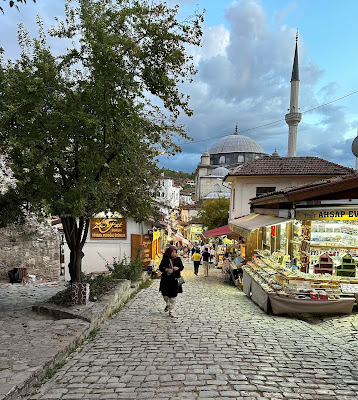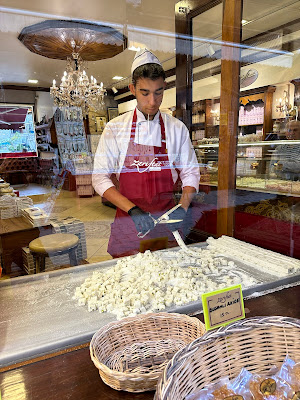 |
| Safranbolu |
Turkey’ Black Sea Coast – from the northern end of the Bosphorus just east of Istanbul to the frontier with Georgia - is off the radar for most people other than Turks.
There’s lots to explore, from mountain villages and ancient monasteries, to seaside towns, with fewer crowds than the more well-known Mediterranean or Aegean destinations, but figuring out where to start is a challenge if you don’t have a car.
There are easier places to begin than the town of Safranbolu in the far northwest corner, but I had my heart set on spending time here from the beginning.
Nestled in canyons, surrounded by mountains, and away from the coast itself, it is not on the way to anything, but in Ottoman times, it was an important stop on the Silk Road trade route between China and the West. Traders came for the saffron, and created a town that retains its cobbled streets, mosques, bathhouses and traditional inns built between the 13th and 17th centuries. More than 2000 18th and 19th century historical homes called konaks, fill the historical center today, some lived in by locals and many transformed into guest houses, hotels, restaurants, shops and cafes.
 |
| Evening in Safranbolu |
And so, the decision was made. After mentally nixing Safranbolu from our itinerary several times due to the hassles of getting in and out, we dug in and committed to a six-hour bus ride from Istanbul for a three-night stay. It will take another three hours to get out and onto our next stop.
These days when you Google a destination for travel information, a list of frequent questions pop up such as “Is Safranbolu worth going to?”
I give it a big Yes. For Turks, it‘s a tourist town, a weekend getaway. They come to eat in the restaurants, and shop the local bazaar for tiny jars of saffron, gift boxes of Turkish Delight and colorful bottles of flower-scented cologne.
 |
| It‘s always time for tea in Turkey |
For visitors like us, it‘s a place to immerse ourselves in a part of Turkey where little English is spoken, where we can walk everywhere, and stay in a welcoming konak with a 250-year-old history.
No car. No problem. The owner of Gunes Konak guesthouse picked us up at the bus station (We communicated on WhatsApp using Google Translater). Our second-floor room, on a hill overlooking the town, has a modern bath and shower, but also creaky floorboards, crooked doorways and wooden window latches.
There’s a prayer rug stashed in the corner and a tiny arrow point to Mecca on the ceiling. The local mosque plays the Call to Prayer over loud speakers at inconvenient times.
It’s all about becoming part of a neighborhood for a few days where a simple “Merhaba” (Turkish for hello) goes a long way.
 |
| Gunes Konak guesthouse |
 |
| Our Turkish neighbors. A simple “Hello” in Turkish produces smiles |
The $70 rate includes breakfast prepared by three women busy in the kitchen before 8:30 a.m. Waiting for us are platters of olives, cucumbers, tomatoes and cheeses; fresh bread; four types of homemade jam; fried eggs sizzling in a copper pan; a Turkish version of French toast; a roasted pepper and olive spread; and endless glasses of steaming Turkish tea.
 |
| Breakfast platter with Simit, a circular bread encrusted with sesame seeds. |
In 1994 Safranbolu was placed in the world Cultural Heritage list by UNESCO in appreciation of the efforts towards preservation of its heritage as a whole, but especially its traditional houses, reflecting the Turkish social life of the 18th and 19th centuries.
The size and the planning of the houses were determined by the large size of the families. Uniformly made with white stucco, brown shutters and red tile roofs, most are are two or three stories, with delicate woodwork and carved wall and ceiling decorations. They were built to line up so as not to block each other’s light, prompting architectural historians to characterize them as early examples of socially responsible building design.
The whole town is walkable, but the narrow streets are steep and laid with rough stones. Most people come here with cars.
 |
| Logging lots of steps |
The city’s name comes from saffron which is native to Safranbolu. We will just miss the annual autumn harvest when fields will be covered with purple flowers. These days, more saffron is imported into Turkey than exported, but the government is taking steps to encourage more production. Our B&B host recently planted a small saffron garden for his guests.
 |
| Saffron for sale in the bazaar |
Small jars of real Safranbolu saffron sell for around $10. Some sells for less, but we were told it comes from Iran.
 |
| Turkish Delight is shaped like a rope, then cut into bite-sized pieces |
Turkish Delight or Lokum is another sought-after local treat. Every shop employs someone to stand outside with a tray of free samples. Based on a gel of starch and sugar, it comes in many flavors, including saffron, Turkish coffee and Oreo. Safronbolu‘s version is said to be unique due to the town’s hard water.
Bakers, blacksmiths, shoemakers and coppersmiths also contributed to the economy in the past. A few still ply their trades in back alleys, but most of the traditional workshops have been replaced by souvenir stalls. Our neighborhood has its own simit baker. It’s fun to watch as he shapes his dough into circles before baking it in a wood-fired oven.
Our favorite building is the Cinci Han (inn) built in 1640 as a caravanserai - a way station for traveling traders. Restored in 2004 as a hotel, it is made completely out of stone.
A coffee museum runs a cafe on the second floor overlooking an open courtyard. Here you can sample various kinds of Turkish coffee, served elegantly on little gold platters along with small glasses of juice and a square of Turkish Delight.
All this for half the the price of a Starbucks latte. Naturally, we have become regulars.
Next stop: Trabzon






It's delightful to travel vicariously with you guys, keep it up!
ReplyDeleteThanks Carol. The descriptions given by you and Tom along with the photos give a real sense of being there. I must say you two are hardy travelers! Don't know that I would take a 6 hour bus ride. Did that in my 20's but not so sure I would be that patient now. Susan
ReplyDelete